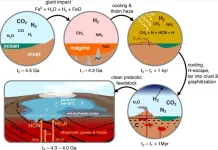Now, a new study from the Institut de Ciències del Mar (ICM-CSIC) recently published in the journal Microbiome highlights the potential of marine microbial populations as indicators of global change. Specifically, the work analyzes the knowledge generated to date on marine microbial populations and their role in the ecosystem, concluding that their analysis through space and time could reflect the effects of global change.
"This is because small genetic changes in these populations could be more directly correlated with the slight but continuous environmental changes associated with global change, than the analysis of species," explains Ramiro Logares, the study’s author. According to the researcher, this would not have been possible without new molecular and computational techniques, which have made it possible to explore at the genetic level and in a more generalized way the distribution and diversity of microbial populations in their natural environments. "These approaches have made it possible to detect genetic variations that could reflect adaptations to environmental changes at contemporary scales, i.e., decades or years," adds Logares.
Large-scale application of molecular techniques
The study of the variability of microorganism populations has been possible thanks to the large-scale application of molecular techniques such as metagenomics and metatranscriptomics, which have revolutionized the ability to analyze these populations directly from their habitats, overcoming some of the limitations of traditional laboratory culture methods.
Specifically, genetic data from uncultured aquatic microbial species were compiled for this study. The results indicated substantial genetic diversity in marine microbial populations and identified distinct patterns of population differentiation and adaptation. This highlights the important role of environmental selection, determined, among other things, by temperature, in structuring microbial populations.
"This work highlights the importance of increasing our understanding of microbial populations in the ocean. Knowing the genetic diversity and population dynamics of marine microbes allows us to obtain valuable information on their resilience or vulnerability to global change," points out Logares.
Overall, the work, based on a review of more than 150 articles, delves into the characteristics and structure of microbial populations, offering a complete view of how the genetic variability of populations can be related to ecosystem processes and evolutionary adaptations.
The study also highlights the importance of understanding microbial populations in the context of global change and their role within the marine ecosystem. In the ocean, microbes are responsible for processes such as nutrient recycling or pollutant decomposition, the efficiency of which may depend on the characteristics of microbial populations.
For this reason, the author advocates continuing to delve deeper into population genomics to unravel this still poorly understood dimension of microbial diversity, which, he predicts, "will lead to a better understanding of the architecture and functioning of the marine microbiome, something that, in turn, will help to design better management and conservation strategies".
Animal and plant populations have been extensively studied, which has helped to understand ecosystem processes and evolutionary adaptations. However, this has not been the case with microbial populations due to the impossibility of isolating, culturing and analyzing the genetic content of the different species and their individuals in the laboratory. Therefore, although it is known that populations of microorganisms include a great diversity, this remains largely uncharacterized.
Now, a new study from the Institut de Ciències del Mar (ICM-CSIC) recently published in the journal Microbiome highlights the potential of marine microbial populations as indicators of global change. Specifically, the work analyzes the knowledge generated to date on marine microbial populations and their role in the ecosystem, concluding that their analysis through space and time could reflect the effects of global change.
"This is because small genetic changes in these populations could be more directly correlated with the slight but continuous environmental changes associated with global change, than the analysis of species," explains Ramiro Logares, the study’s author. According to the researcher, this would not have been possible without new molecular and computational techniques, which have made it possible to explore at the genetic level and in a more generalized way the distribution and diversity of microbial populations in their natural environments. "These approaches have made it possible to detect genetic variations that could reflect adaptations to environmental changes at contemporary scales, i.e., decades or years," adds Logares.
Large-scale application of molecular techniques
The study of the variability of microorganism populations has been possible thanks to the large-scale application of molecular techniques such as metagenomics and metatranscriptomics, which have revolutionized the ability to analyze these populations directly from their habitats, overcoming some of the limitations of traditional laboratory culture methods.
Specifically, genetic data from uncultured aquatic microbial species were compiled for this study. The results indicated substantial genetic diversity in marine microbial populations and identified distinct patterns of population differentiation and adaptation. This highlights the important role of environmental selection, determined, among other things, by temperature, in structuring microbial populations.
"This work highlights the importance of increasing our understanding of microbial populations in the ocean. Knowing the genetic diversity and population dynamics of marine microbes allows us to obtain valuable information on their resilience or vulnerability to global change," points out Logares.
Elena Martínez | elenamb@icm.csic.es
Communication and dissemination office ICM-CSIC
Overall, the work, based on a review of more than 150 articles, delves into the characteristics and structure of microbial populations, offering a complete view of how the genetic variability of populations can be related to ecosystem processes and evolutionary adaptations.
The study also highlights the importance of understanding microbial populations in the context of global change and their role within the marine ecosystem. In the ocean, microbes are responsible for processes such as nutrient recycling or pollutant decomposition, the efficiency of which may depend on the characteristics of microbial populations.
For this reason, the author advocates continuing to delve deeper into population genomics to unravel this still poorly understood dimension of microbial diversity, which, he predicts, "will lead to a better understanding of the architecture and functioning of the marine microbiome, something that, in turn, will help to design better management and conservation strategies".
Elena Martínez | elenamb@icm.csic.es
Communication and dissemination office ICM-CSIC
END




